Influence of Cu(II) Ion Concentration on Copper Electrodeposition from Deep Eutectic Solvent on Inert Substrate
Abstract
1. Introduction
2. Materials and Methods
2.1. Preparation of Cu(II)-Ethaline Electrolyte
2.2. Electrode and Instrumentation
2.3. Deposit Characterization
3. Results
3.1. Investigation of Cu2+ Redox Processes in 0.01 M and 0.5 M Cu(II)-Ethaline Using Voltammetry Analysis
3.2. Morphological Analysis of Cu Deposits Electrodeposited from Ethaline Electrolytes
3.3. Structural Analysis of Cu Deposit Electrodeposited from Ethaline
4. Discussion
5. Conclusions
Supplementary Materials
Author Contributions
Funding
Data Availability Statement
Acknowledgments
Conflicts of Interest
Abbreviations
| ChCl | Choline chloride |
| EG | Ethylene glycol |
| Ethaline | ChCl:EG (1:2) electrolyte |
| CV | Cyclic voltammetry |
| DES | Deep eutectic solvents |
| ILs | Ionic liquids |
| Pd | Palladium |
| GC | Glassy carbon |
| Au | Gold |
| Pt | Platinum |
| Cu | Copper |
| CE | Counter electrode |
| WE | Working electrode |
| RE | Quasi-reference electrode |
| SEM | Scanning electron microscope |
| EDS | Energy-dispersive X-ray spectroscopy |
| XRD | X-ray diffraction |
| Ec | Cathodic end potential |
| Ei | Initial potential |
| Ep | Shift in cathodic peak potential |
| FCC | Face-centered cubic lattice |
| TC(hkl) | Texture coefficients |
| RTC(hkl) | Relative texture coefficients |
References
- Hansen, B.B.; Spittle, S.; Chen, B.; Poe, D.; Zhang, Y.; Klein, J.M.; Horton, A.; Adhikari, L.; Zelovich, T.; Doherty, B.W.; et al. Deep Eutectic Solvents: A Review of Fundamentals and Applications. Chem. Rev. 2021, 121, 1232–1285. [Google Scholar] [CrossRef] [PubMed]
- Yu, D.; Xue, Z.; Mu, T. Deep Eutectic Solvents as a Green Toolbox for Synthesis. Cell Rep. Phys. Sci. 2022, 3, 100809. [Google Scholar] [CrossRef]
- Kaur, G.; Kumar, H.; Singla, M. Diverse Applications of Ionic Liquids: A Comprehensive Review. J. Mol. Liq. 2022, 351, 118556. [Google Scholar] [CrossRef]
- De Vreese, P.; Brooks, N.R.; Van Hecke, K.; Van Meervelt, L.; Matthijs, E.; Binnemans, K.; Van Deun, R. Speciation of Copper(II) Complexes in an Ionic Liquid Based on Choline Chloride and in Choline Chloride/Water Mixtures. Inorg. Chem. 2012, 51, 4972–4981. [Google Scholar] [CrossRef]
- Kityk, A.; Pavlik, V.; Hnatko, M. Exploring Deep Eutectic Solvents for the Electrochemical and Chemical Synthesis of Photo- and Electrocatalysts for Hydrogen Evolution. Int. J. Hydrogen Energy 2023, 48, 39823–39853. [Google Scholar] [CrossRef]
- Zhou, T.; Gui, C.; Sun, L.; Hu, Y.; Lyu, H.; Wang, Z.; Song, Z.; Yu, G. Energy Applications of Ionic Liquids: Recent Developments and Future Prospects. Chem. Rev. 2023, 123, 12170–12253. [Google Scholar] [CrossRef]
- Abbott, A.P.; El Ttaib, K.; Frisch, G.; McKenzie, K.J.; Ryder, K.S. Electrodeposition of Copper Composites from Deep Eutectic Solvents Based on Choline Chloride. Phys. Chem. Chem. Phys. 2009, 11, 4269–4277. [Google Scholar] [CrossRef]
- Sebastián, P.; Vallés, E.; Gómez, E. Copper Electrodeposition in a Deep Eutectic Solvent. First Stages Analysis Considering Cu(I) Stabilization in Chloride Media. Electrochim. Acta 2014, 123, 285–295. [Google Scholar] [CrossRef]
- Haerens, K.; Matthijs, E.; Binnemans, K.; Van der Bruggen, B. Electrochemical Decomposition of Choline Chloride Based Ionic Liquid Analogues. Green Chem. 2009, 11, 1357. [Google Scholar] [CrossRef]
- Vukmirovic, M.B.; Adzic, R.R.; Akolkar, R. Copper Electrodeposition from Deep Eutectic Solvents—Voltammetric Studies Providing Insights into the Role of Substrate: Platinum vs Glassy Carbon. J. Phys. Chem. B 2020, 124, 5465–5475. [Google Scholar] [CrossRef]
- Yue, D.; Jia, Y.; Yao, Y.; Sun, J.; Jing, Y. Structure and Electrochemical Behavior of Ionic Liquid Analogue Based on Choline Chloride and Urea. Electrochim. Acta 2012, 65, 30–36. [Google Scholar] [CrossRef]
- Kityk, A.; Pavlik, V.; Hnatko, M. Breaking Barriers in Electrodeposition: Novel Eco-Friendly Approach Based on Utilization of Deep Eutectic Solvents. Adv. Colloid Interface Sci. 2024, 334, 103310. [Google Scholar] [CrossRef]
- Geng, T.; Zeller, S.J.; Kibler, L.A.; Ceblin, M.U.; Jacob, T. Electrodeposition of Cu onto Au(111) from Deep Eutectic Solvents: Molar Ratio of Salt and Hydrogen Bond Donor. ChemElectroChem 2022, 9, e202101283. [Google Scholar] [CrossRef]
- Shen, D.; Vukmirovic, M.B.; Akolkar, R. Understanding the Role of Complexation in the Charge-Transfer Kinetics of the Cu2+ + e− ↔ Cu1+ Redox Reaction in Ethaline Deep Eutectic Solvent. J. Electrochem. Soc. 2019, 166, E526–E532. [Google Scholar] [CrossRef]
- Cvetković, V.S.; Jović, V.D.; Nikolić, N.D.; Barudžija, T.S.; Dimitrijević, S.; Jovićević, J.N. Electrodeposition of Copper on Glassy Carbon and Palladium from Choline Chloride—Ethylene Glycol Deep Eutectic Solvent. J. Electroanal. Chem. 2024, 958, 118161. [Google Scholar] [CrossRef]
- Xing, S.; Zanella, C.; Deflorian, F. Effect of Pulse Current on the Electrodeposition of Copper from Choline Chloride-Ethylene Glycol. J. Solid State Electrochem. 2014, 18, 1657–1663. [Google Scholar] [CrossRef]
- Ghosh, S.; Roy, S. Electrochemical Copper Deposition from an Ethaline-CuCl2·2H2O DES. Surf. Coat. Technol. 2014, 238, 165–173. [Google Scholar] [CrossRef]
- Zhao, W.; Fu, W.; Yang, H.; Tian, C.; Li, M.; Li, Y.; Zhang, L.; Sui, Y.; Zhou, X.; Chen, H.; et al. Electrodeposition of Cu2O Films and Their Photoelectrochemical Properties. CrystEngComm 2011, 13, 2871–2877. [Google Scholar] [CrossRef]
- Wijesundera, R.P.; Hidaka, M.; Koga, K.; Sakai, M.; Siripala, W. Growth and Characterisation of Potentiostatically Electrodeposited Cu2O and Cu Thin Films. Thin Solid Films 2006, 500, 241–246. [Google Scholar] [CrossRef]
- Zaidi, N.; Makhloufi, L.; Mandin, P.; Touazi, S.; Hammache, H. Copper Oxide Electrodeposition onto Aluminium Substrate Exploration: New Insights in the Copper Oxide Electrodeposition from Ionic Liquids and Deep Eutectic Solvents. Bull. Mater. Sci. 2021, 44, 1–11. [Google Scholar] [CrossRef]
- Hu, Y.; Chen, P.S.; Ko, Y.C.; Tsai, C.H. Electrochemical Deposition and Characterization of Cuprous Oxide Crystallites on Stainless Substrates: Growth Mechanism and Morphological Analysis. Int. J. Electrochem. Sci. 2024, 19, 100688. [Google Scholar] [CrossRef]
- Nikolić, N.D.; Maksimović, V.M.; Avramović, L. Correlation of Morphology and Crystal Structure of Metal Powders Produced by Electrolysis Processes. Metals 2021, 11, 859. [Google Scholar] [CrossRef]
- Popov, K.I.; Djokić, S.S.; Nikolić, N.D.; Jović, V.D. Morphology of Electrochemically and Chemically Deposited Metals; Springer International Publishing: New York, NY, USA, 2016; ISBN 978-3-319-26071-6. [Google Scholar]
- Cvetković, V.S.; Nikolić, N.D.; Barudžija, T.S.; Dimitrijević, S.B.; Jovićević, J.N. Electrodeposition of Dendrite-Free Zn on Au from Deep Eutectic System Based on Choline Chloride. Trans. Nonferrous Met. Soc. China 2024, 34, 2367–2380. [Google Scholar] [CrossRef]
- Cvetković, V.S.; Vukićević, N.M.; Jovićević, N.; Stevanović, J.S.; Jovićević, J.N. Aluminium Electrodeposition under Novel Conditions from AlCl3–Urea Deep Eutectic Solvent at Room Temperature. Trans. Nonferrous Met. Soc. China 2020, 30, 823–834. [Google Scholar] [CrossRef]
- Milhano, C.; Pletcher, D. The Electrodeposition and Electrocatalytic Properties of Copper-Palladium Alloys. J. Electroanal. Chem. 2008, 614, 24–30. [Google Scholar] [CrossRef]
- Vieira, L.; Schennach, R.; Gollas, B. The Effect of the Electrode Material on the Electrodeposition of Zinc from Deep Eutectic Solvents. Electrochim. Acta 2016, 197, 344–352. [Google Scholar] [CrossRef]
- Greef, R.; Peat, R.; Peter, L.M.; Pletcher, D.; Robinson, J. Instrumental Methods in Electrochemistry, 1st ed.; Kemp, T.J., Ed.; Ellis Horwood Limited: Chichester, UK, 1985; ISBN 0-85312-875-8. [Google Scholar]
- Espinoza, E.M.; Clark, J.A.; Soliman, J.; Derr, J.B.; Morales, M.; Vullev, V.I. Practical Aspects of Cyclic Voltammetry: How to Estimate Reduction Potentials When Irreversibility Prevails. J. Electrochem. Soc. 2019, 166, H3175–H3187. [Google Scholar] [CrossRef]
- Bérubé, L.P.; L’Espérance, G. A Quantitative Method of Determining the Degree of Texture of Zinc Electrodeposits. J. Electrochem. Soc. 1989, 136, 2314–2315. [Google Scholar] [CrossRef]
- Mandke, M.V.; Han, S.-H.; Pathan, H.M. Growth of Silver Dendritic Nanostructuresvia Electrochemical Route. CrystEngComm 2012, 14, 86–89. [Google Scholar] [CrossRef]
- Hartley, J.M.; Ip, C.M.; Forrest, G.C.H.; Singh, K.; Gurman, S.J.; Ryder, K.S.; Abbott, A.P.; Frisch, G. EXAFS Study into the Speciation of Metal Salts Dissolved in Ionic Liquids and Deep Eutectic Solvents. Inorg. Chem. 2014, 53, 6280–6288. [Google Scholar] [CrossRef]
- Bontempelli, G.; Dossi, N.; Toniolo, R. Linear Sweep and Cyclic. In Reference Module in Chemistry, Molecular Sciences and Chemical Engineering; G. Bontempelli, R.T., Ed.; Elsevier: New York, NY, USA, 2016; pp. 188–197. [Google Scholar]
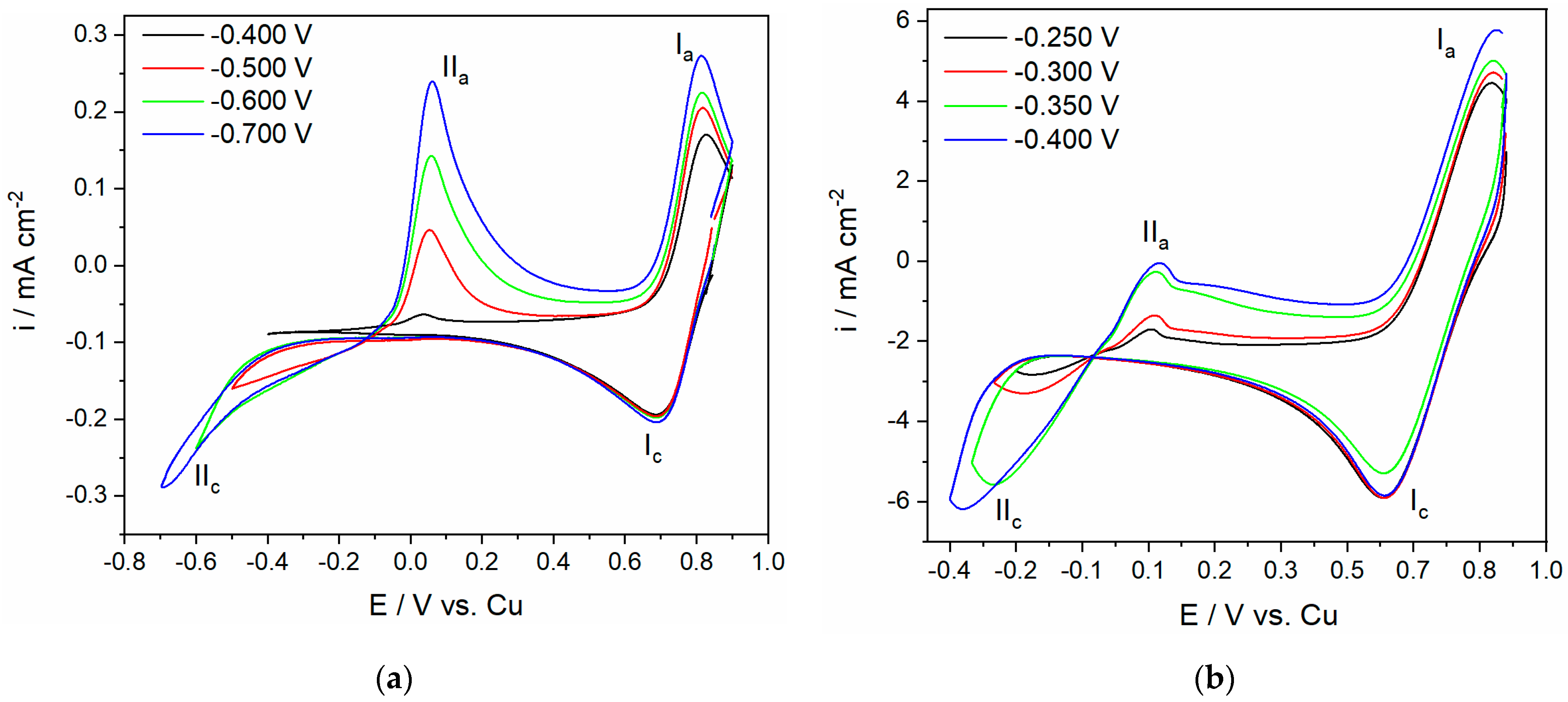
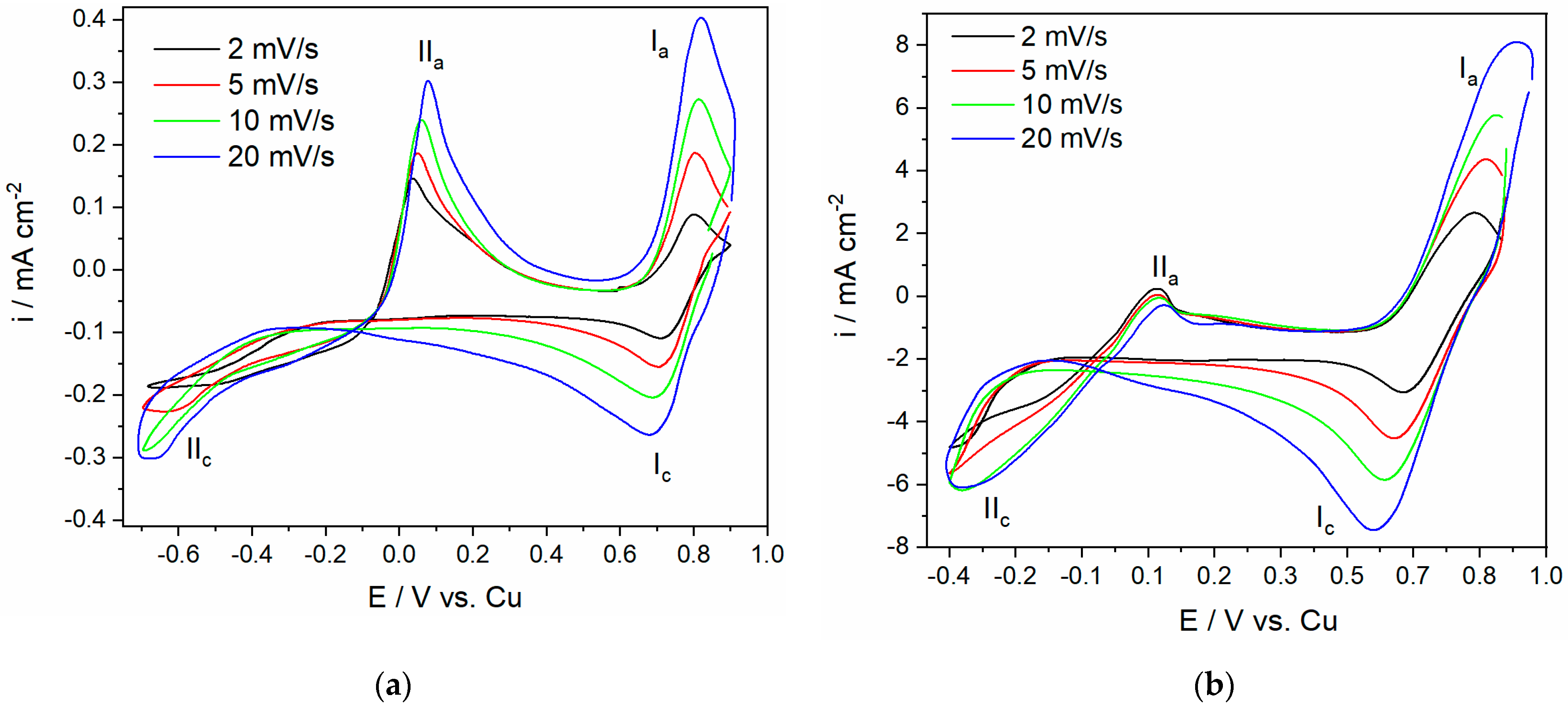
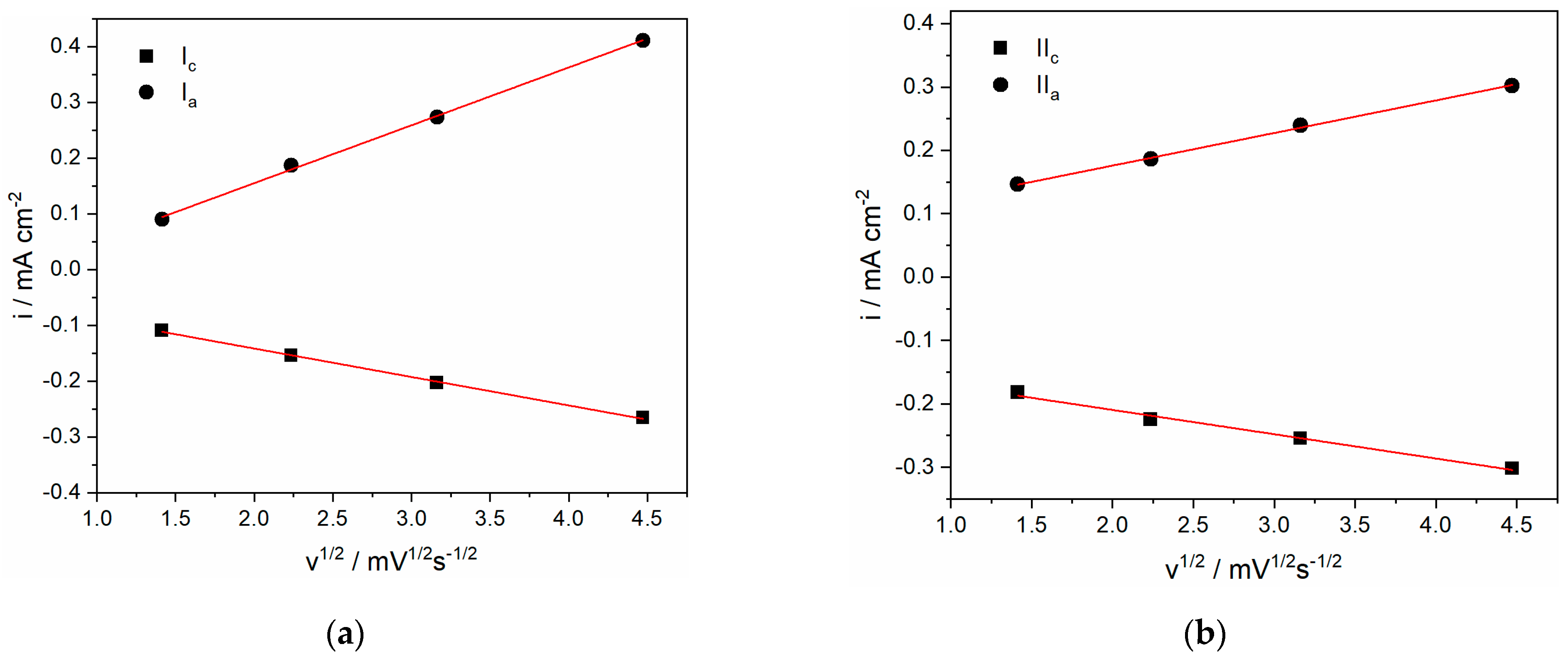
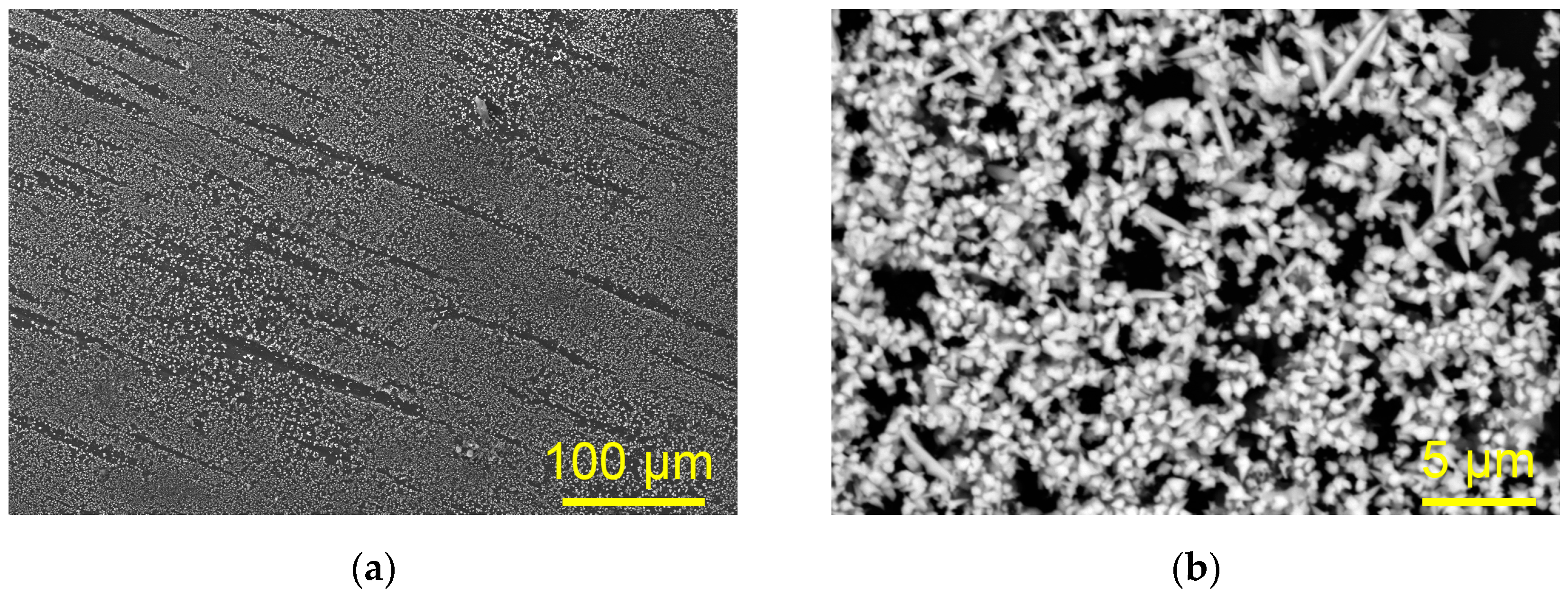
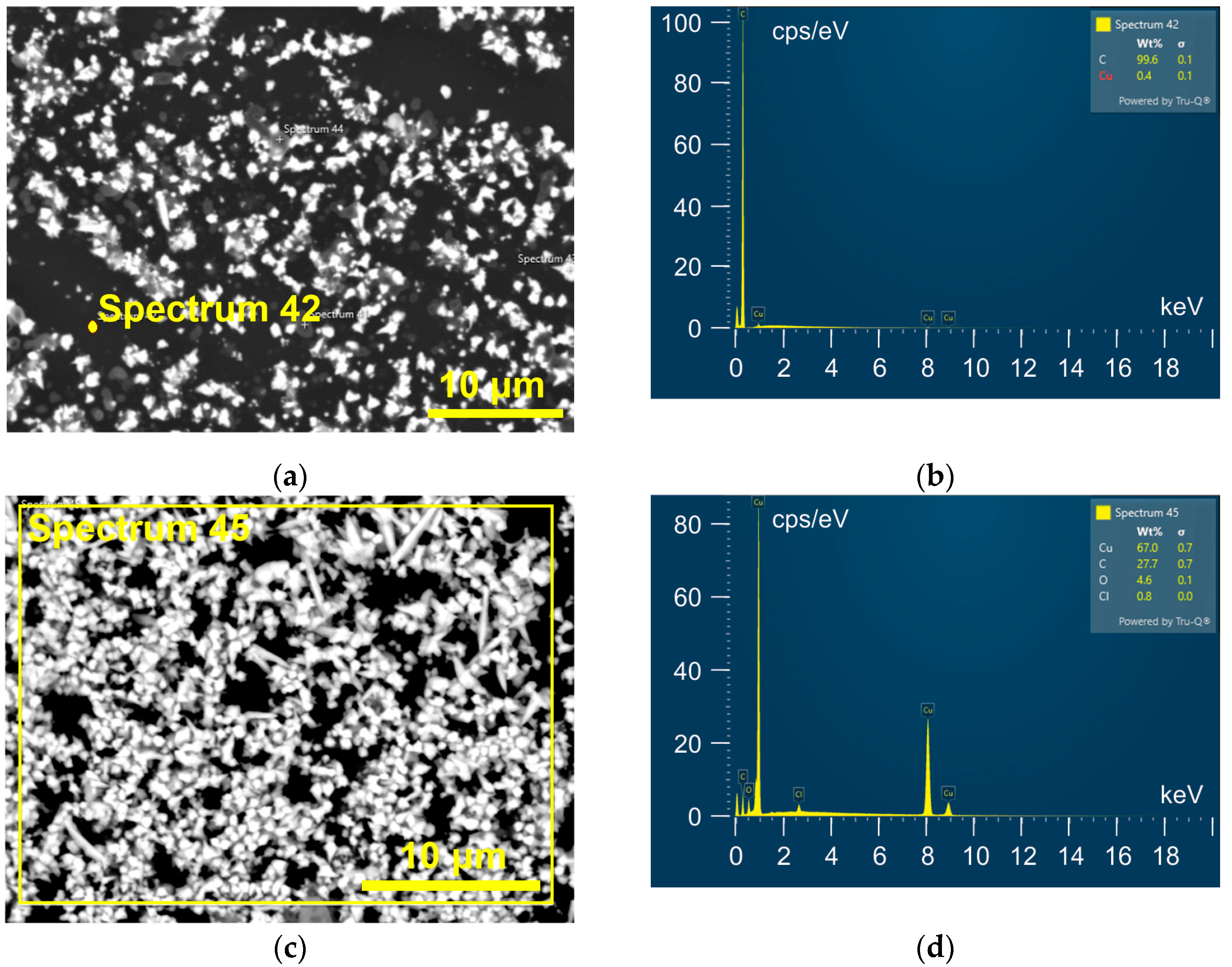
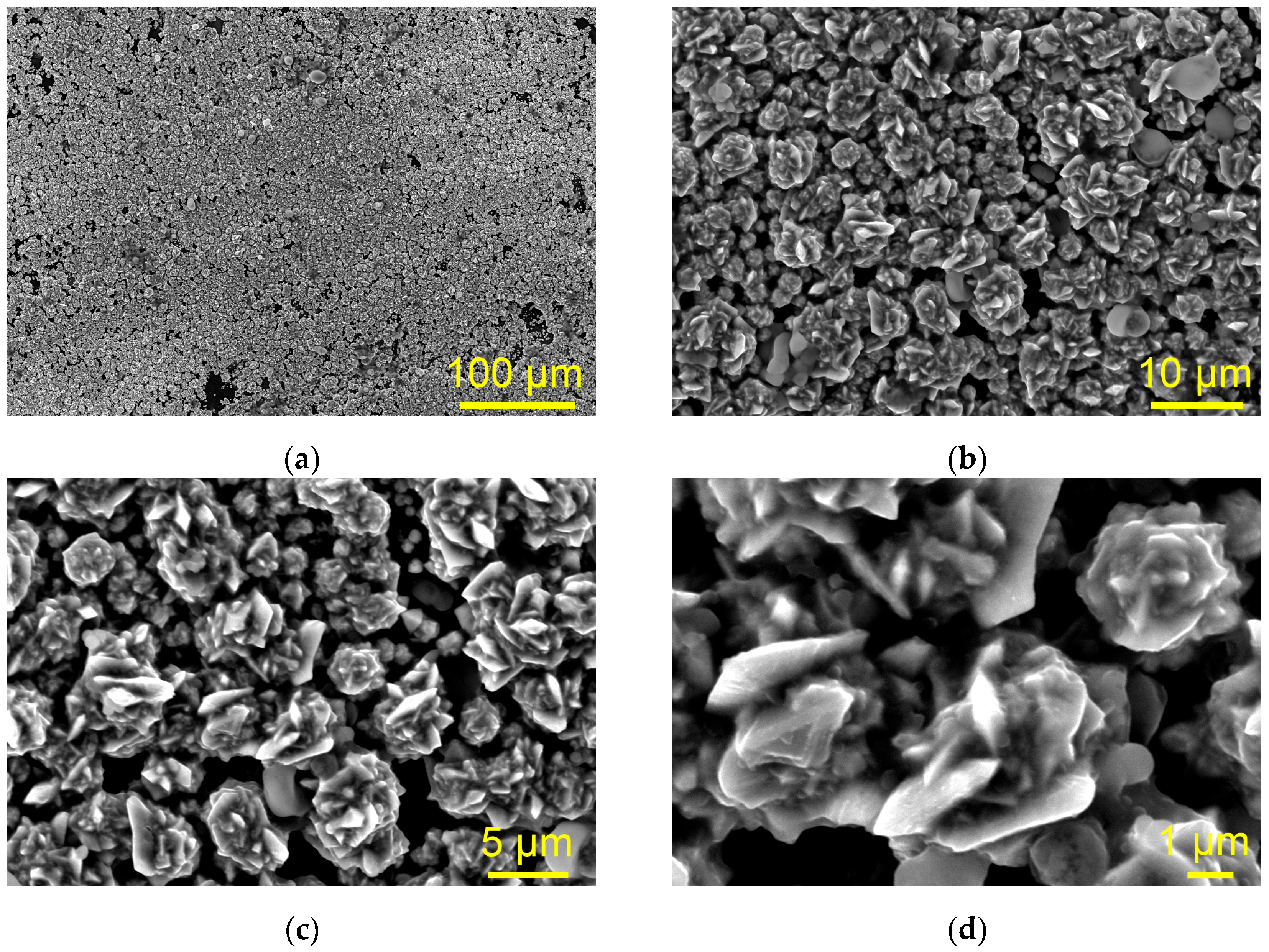
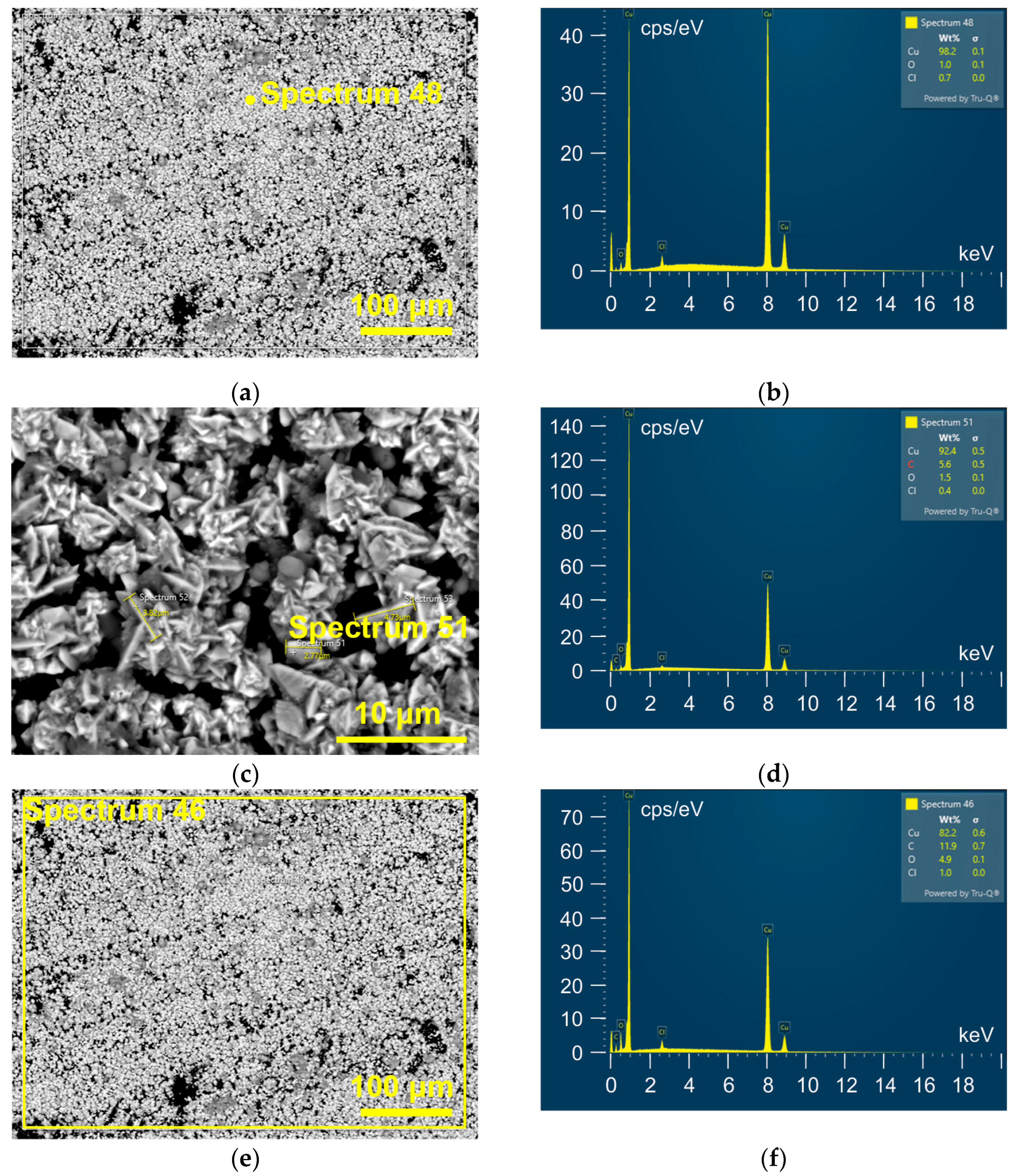

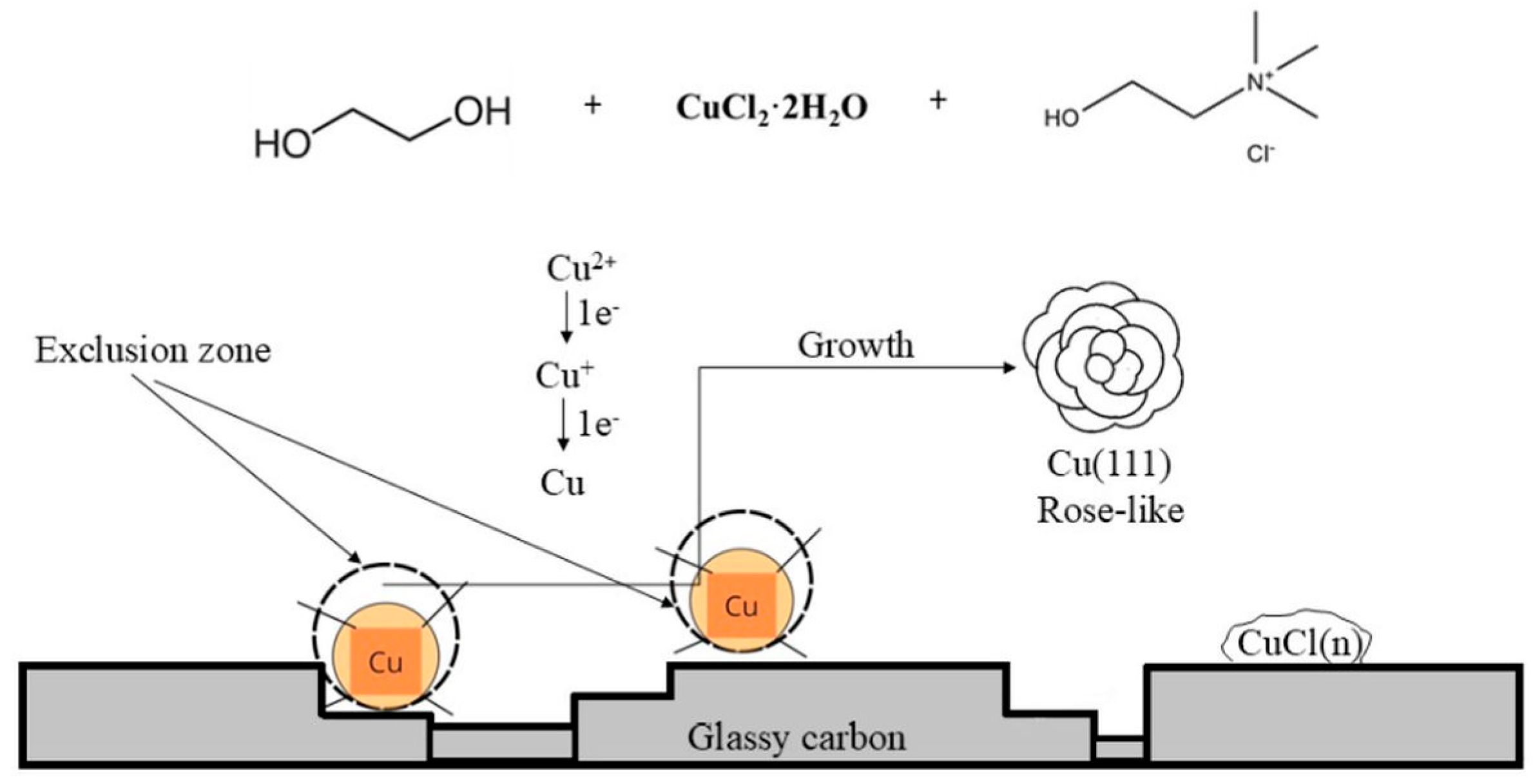
| Peak Intensity Ratios | ||
|---|---|---|
| (111)/(200) | (111)/(220) | |
| Rose-shaped particles | 2.92 | 7.09 |
| Cu standard (04-0836) | 2.17 | 5.0 |
Disclaimer/Publisher’s Note: The statements, opinions and data contained in all publications are solely those of the individual author(s) and contributor(s) and not of MDPI and/or the editor(s). MDPI and/or the editor(s) disclaim responsibility for any injury to people or property resulting from any ideas, methods, instructions or products referred to in the content. |
© 2025 by the authors. Licensee MDPI, Basel, Switzerland. This article is an open access article distributed under the terms and conditions of the Creative Commons Attribution (CC BY) license (https://creativecommons.org/licenses/by/4.0/).
Share and Cite
Cvetković, V.S.; Petrović, N.M.; Nikolić, N.D.; Jovićević, J.N. Influence of Cu(II) Ion Concentration on Copper Electrodeposition from Deep Eutectic Solvent on Inert Substrate. Metals 2025, 15, 716. https://doi.org/10.3390/met15070716
Cvetković VS, Petrović NM, Nikolić ND, Jovićević JN. Influence of Cu(II) Ion Concentration on Copper Electrodeposition from Deep Eutectic Solvent on Inert Substrate. Metals. 2025; 15(7):716. https://doi.org/10.3390/met15070716
Chicago/Turabian StyleCvetković, Vesna S., Nataša M. Petrović, Nebojša D. Nikolić, and Jovan N. Jovićević. 2025. "Influence of Cu(II) Ion Concentration on Copper Electrodeposition from Deep Eutectic Solvent on Inert Substrate" Metals 15, no. 7: 716. https://doi.org/10.3390/met15070716
APA StyleCvetković, V. S., Petrović, N. M., Nikolić, N. D., & Jovićević, J. N. (2025). Influence of Cu(II) Ion Concentration on Copper Electrodeposition from Deep Eutectic Solvent on Inert Substrate. Metals, 15(7), 716. https://doi.org/10.3390/met15070716









